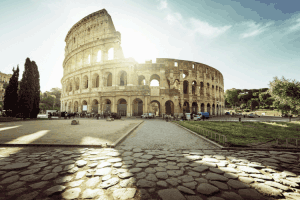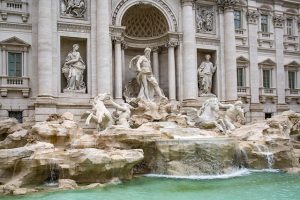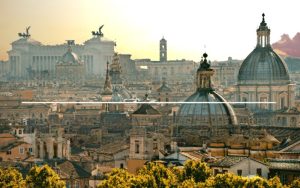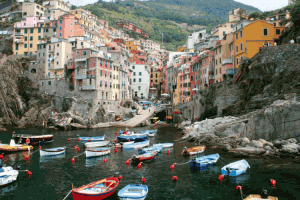One of the reasons why globetrotters flock to Italy is to admire the country’s love of art. Italy is prominent for its renaissance heritage that reflects in its stupendous architectural structures and gorgeous display of art.
A leisure stroll through Italy’s popular cities takes you through a myriad of statues, colossal buildings, and breathtaking art installations. The ancient Italian era had a penchant to spruce up its public spots with exceptionally designed fountains, which presently are some of the most captivating sights of Italy. The eternal city of Rome has some of the best collection of Italian Fountains and is home to nearly 2000 stunning fountains. However, other destinations in Italy also share its creation of beautiful fountain dominating piazzas. What started as a way to quench the thirst of needy masses soon turned into magnificent tourist attractions for Italy visitors. Intricately carved forms and structures spouting and gushing out jets of waters into tranquil pools, each fountain in Italy has a tale of its own to tell.
Must-Visit Fountains of Italy:
1. Trevi Fountain – Rome
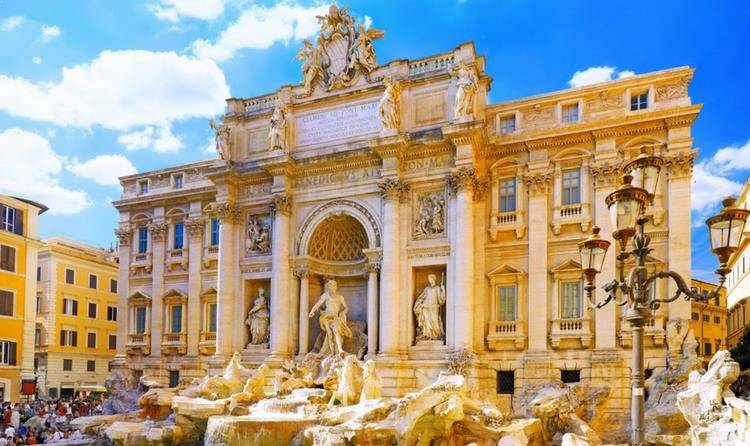
The most prominent and popular fountain in all of Italy is the Trevi Fountain in Rome. A masterpiece creation by Italian architect Nicola Salvi and Pietro Bracci, Trevi Fountain is the largest fountain in Rome and features as one of the best places to visit in Italy. In fact, your trip to Rome is incomplete if you haven’t witnessed the grandeur of this manmade architectural marvel. A breathtaking remainder of Baroque architecture, Trevi Fountain is nestled in Quirinale district of Rome at an intersection of three roads which gave the fountain its name as Trevi or Three street Fountain. The fountain is built at the end of Aqua Virgo – an aqueduct built in19th century and till date supplies the water from Salone Spring to feed the fountain. This grand triumphal arch-like fountain has sculptures of Neptune, God of Sea riding his shell-shaped chariot driven by two horses – one calm and the other agitated depicting the unpredictable mood of the sea. Millions of tourists fling coins into the fountain basin as it is believed that tossing a coin into the Trevi Fountain will bring them back to Rome in future.
2. Fountain of Four Rivers – Rome
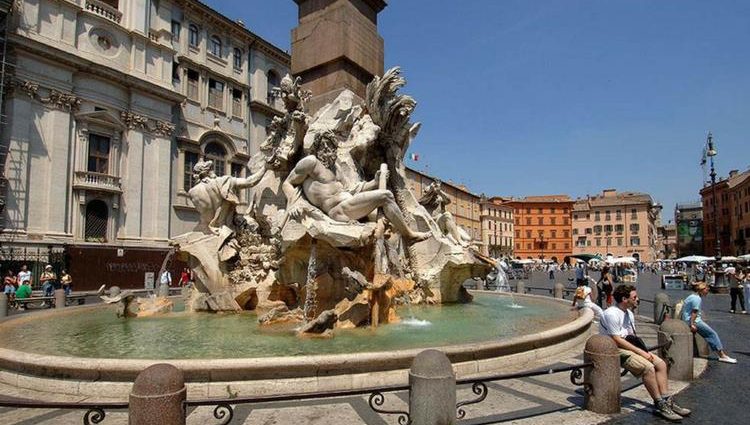
One of the grandest theatrical fountains in Rome, Fontana dei Quattro Fiumi or Fountain of Four Rivers dominates the ambiance at Piazza Navona in Rome. The fountain is graced by four massive statues each depicting prominent rivers of four continents namely Nile of Africa, Danube of Europe, Ganges of Asia and Rio de la Plata of Americas. Designed by Gian Lorenzo Bernini, the fountain’s colossal statues are arranged in a round basin structure with an Egyptian obelisk perched with a dove with an olive twig towering over them. The fascinating aspect of this monumental fountain is that Bernini has hidden many intricate emblematic meaning in his design which are soaked in political symbolism, rival parody, and religious allegory.
3. La Fontana di Pretoria – Palermo, Sicily
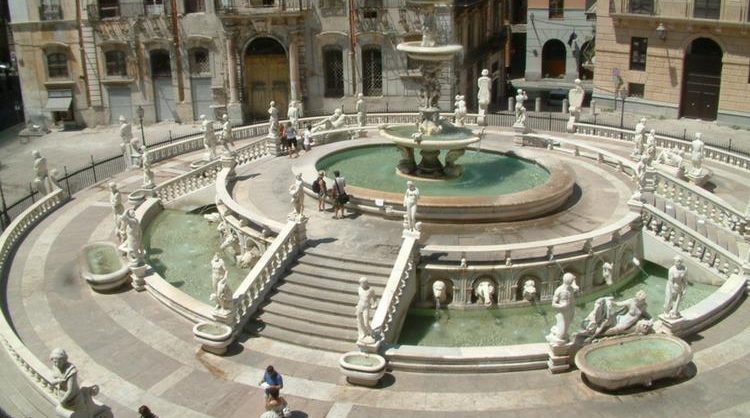
Though this fountain may not be considered modest and tasteful characteristically, La Fontana di Pretoria still manages to be one of the major landmarks of Palermo. Originally built for the garden of don Luigi de Toledo in Florence, this grand marble fountain was relocated to Piazza Pretoria in Palermo, Sicily in 644 pieces which were then rearranged in its current location. Sculpted by Francesco Camilliani, the fountain has a tiered basin set on top of concentric steps dotted with unrobed statues of the Twelve Olympians, decorated with more than 50 statues of animals, mythological creatures, and monsters. Due to its grotesque elements, and nudity, the fountain came to known as the Fountain of Shame by the locals of Palermo as it is believed to represent the corrupt municipalities of the township. The fountain is set in one of the loveliest piazzas in Sicily and overlooks Santa Caterina and San Giuseppe dei Teatini.
4. The Grand Cascade at Royal Palace – Caserta
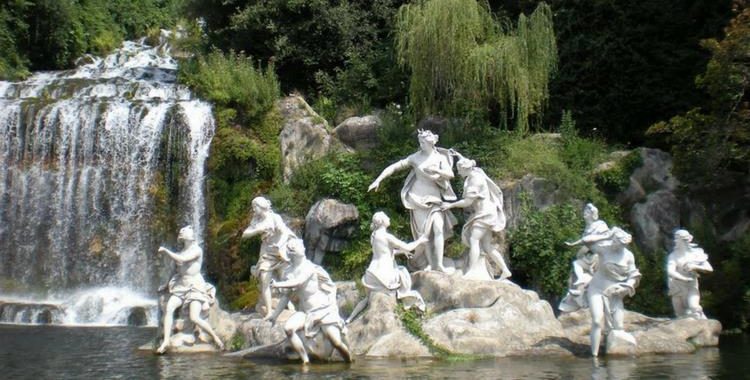
The Royal Palace of Caserta is a magnificent palace built in Baroque style for the king of Naples which is now a UNESCO World Heritage Site. Within the Royal Palace lies the Grand Cascade of Caserta – a beautiful waterfall with fountain of Diana and Acteon at its basin. Sculpted by Paolo Persico, Angelo Maria Brunelli, and Tommaso Solar, both these fountains are beautiful masterpieces of the 18th-century era. Though the Grand Cascade and the Fountains of Diana and Acteon are renowned for its picturesque panorama, the park of Royal Palace is peppered with many such fascinating spouts and springs merged with amazing sculpted structures.
5. Fontana dell’Elefante – Catania, Sicily
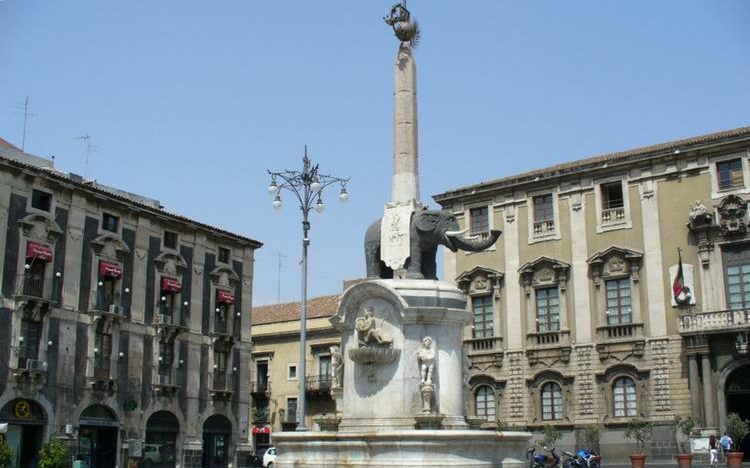
On your trip to Italy if you are in Catania in Sicily, you should certainly visit the Piazze del Duomo. Right at the centre of this enthralling Italian piazza stands Fontana dell’Elefante or the Fountain of Elephant. Built in 1736 by Giovanni Battista Vaccarini, the fountain has a statue of a smiling elephant supporting an obelisk wholly made out of lava stones. There is a magical legend about the fountain that the sculpted elephant was once owned by an 8th-century magician Eliodorus. The fountain is a major landmark and symbol of Catania and surrounding the fountain is the beautiful buildings of Baroque style architecture.
6. Fountain of Neptune – Florence
Take a quick high-speed rail ride from Rome to Florence to view more of the exquisite Italian architecture.
The Piazza della Signoria’s Fountain of Neptune, Florence’s most famous monument is adorned by visitors.
It was commissioned in the sixteenth century to honor the marriage of the Second Duke of Tuscany and the Grand Duchess Joanna of Austria.
Over the years, it has endured numerous significant alterations, many of which were brought on by abuse and vandalism. Even Nevertheless, following striking renovations, it is once more among Italy’s most popular and well-known fountains. View the elaborate Zodiac sign displays and Renaissance designs!
7. Fontana del Moro – Rome
Fontana del Moro is one of the capital city’s more intriguing and unique fountains that is Located at the southern end of Piazza Navona. Fontana del Moro is a must-visit location that provides insight into both African and Moorish traditions situated in the heart of Italy!
The fountain’s current form is the result of the collaboration of numerous artists, who created and carved masks, tritons, and dragons. All these elements blend in seamlessly with the typical Italian landscape, making Fontana del Moro an even more remarkable piece of architecture.
You should give it a try even though it does not follow the coin-throwing tradition because it is still highly important to the Romans!
8. Elephant Fountain – Catania
The renowned Fountain of the Elephant, built at the start of the 18th century by renowned Sicilian architect Giovanni Battista Vaccarini, symbolizes the long-lost link between Italian art and Egyptian beauty.
While the fountain’s overall meaning and a few facts are widely recognized, many more specifics about its original beginnings are still unknown. Ask around and chat with some locals if you want to get into it; they’ll be sure to have stories to share!
While you may have plenty of options to decide what to see in Italy, you will come across these wonderful fountains while exploring these towns as they form an exquisite part of Italy tourist attractions. It would be impossible to miss the Trevi Fountain or the Fountain of Four Rivers on a city tour of the Eternal City of Rome. And if you do, you will be sorely disappointed for missing an extraordinary spectacle of human artistic creation. These fascinating sculpted marvels of virtuoso found in any prominent places of Italy provide stimulating sites for visitors for photo opportunities on their Italy trip. So next time you get your Italy tourist visa and are busy jotting down a list of Italy tourist places to visit, see to it that you do visit some of the most stellar creations of Italian history entwined with tranquil springs of water to take a break and snap some insta-worthy pictures.
